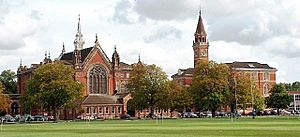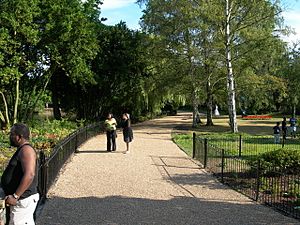Dulwich facts for kids
Quick facts for kids Dulwich |
|
|---|---|
 The historical centre of Dulwich, showing the College of God's Gift (the "Old College") including Christ's Chapel, the Old Grammar School, and the memorial to George Webster. Immediately behind the Old College is Dulwich Picture Gallery |
|
| OS grid reference | TQ345725 |
| London borough | |
| Ceremonial county | Greater London |
| Region | |
| Country | England |
| Sovereign state | United Kingdom |
| Post town | LONDON |
| Postcode district | SE21–SE24, SE26 |
| Dialling code | 020 |
| Police | Metropolitan |
| Fire | London |
| Ambulance | London |
| EU Parliament | London |
| UK Parliament |
|
| London Assembly |
|
Dulwich (pronounced DUL-itch) is a lovely area in south London, England. It's mostly in the London Borough of Southwark, but some parts are in the London Borough of Lambeth. Dulwich includes different neighbourhoods like Dulwich Village, East Dulwich, West Dulwich, and part of Herne Hill. It sits in a valley surrounded by other areas like Camberwell, Crystal Palace, and Forest Hill.
For the past 400 years, Dulwich has been connected to the College of God's Gift, also known as the "Old College." This college owns most of the land in the area today, called the Dulwich Estate. The College was started to help with education and charity. It set up three big private schools in the 1800s: Dulwich College, Alleyn's School, and James Allen's Girls' School. More recently, four large state secondary schools have opened in the area.
Dulwich used to be part of a very old parish called Camberwell in Surrey. Later, it became part of the Metropolitan Borough of Camberwell in London. In 1965, the area became part of the new London Borough of Southwark.
Contents
History of Dulwich
Early Days
The first time Dulwich was written about was in 967 AD. It was a small village outside London, given by King Edgar to one of his important helpers. The name Dulwich has been spelled in many ways over time, like Dylways and Dilwysshe. It likely means "meadow where the dill grew."
In 1127, King Henry I gave the land to Bermondsey Abbey, a religious group that owned the land around it. By 1333, about 100 people lived in Dulwich.
Edward Alleyn's Gift
In 1538, King Henry VIII sold the area to a goldsmith named Thomas Calton for £609. Later, in 1605, Thomas Calton's grandson sold the land for £5,000 to Elizabethan actor and businessman Edward Alleyn.
Edward Alleyn used his money to create a charity called the College of God's Gift in 1619. This charity's modern version, The Dulwich Estate, still owns about 1,500 acres (6.1 km²) in the area. This includes some private roads and a special tollgate. As part of his charity, Alleyn also built a school, the Christ's Chapel (where he is buried), and alms houses (places for people in need). Alleyn's first school building is now used by the Estate's Governors.
In the 1600s, King Charles I of England often visited Dulwich Woods to hunt. People also believed that the water from Dulwich had special healing powers, and it was sold in London streets. In 1739, a man named Mr. Cox found a well with water that helped people feel better. He owned a tavern nearby, and many people came to drink the water and visit his tavern. A path called Cox's Walk was made to connect his tavern to other popular wells.
Growth and Changes
By 1815, the Green Man tavern had become a school called Dr. Glennie's academy. Famous people like Lord Byron went to school there. The building later became a tavern again and is now closed. In 1811–1814, the Dulwich Picture Gallery was built.
The school Edward Alleyn founded grew bigger in 1842. A new building, designed by Sir Charles Barry (who also designed Westminster Palace), was built next to the Old College. In 1857, the school was reorganized and split into two parts: an Upper School (which became Dulwich College) and a Lower School (which became Alleyn's School).
By 1901, the number of people living in Dulwich had grown a lot, from 1,632 in 1851 to over 10,000. This was because of new railway lines and more homes being built for families. During the Second World War, Dulwich was hit by many V-1 flying bombs and V-2 rockets. Some people think the British military might have given wrong map locations to protect central London, causing the bombs to fall more on the suburbs.
What Dulwich is Like Today
Different Areas of Dulwich
Dulwich has several well-known areas:
- Dulwich Village: This is the original centre of the village.
- West Dulwich: A mostly residential area near West Norwood and Tulse Hill.
- Herne Hill (the Southwark half): This area is sometimes called the North Dulwich Triangle and borders Brixton and Denmark Hill.
- Sydenham Hill Wood and Dulwich Wood: These woods are on the southern edge, near Sydenham Hill railway station.
- East Dulwich: Another residential area, next to Peckham.
Dulwich Village and Park
Dulwich Village has its original shopping street and many buildings from the 1700s and 1800s. It still feels very traditional and is a protected area. The village is next to Dulwich Park, where the Dulwich Horse and Motor Show happens every year.
Sports and Fun
Dulwich is home to Dulwich Hamlet F.C., a football club started in 1893. They play at Champion Hill in East Dulwich. The Old Alleynian Football Club is a local rugby union team. It was first for former students of Dulwich College but is now open to everyone. The Dulwich Paragon cycling club is also in the area. Dulwich also has two running clubs, Dulwich Park RC and Dulwich Runners.
Cool Places to See
Parks and Hospitals
Dulwich Park opened in 1890. It used to be farmland. Now, it has ponds for ducks and rowing, a children's play area, a bowling green, tennis courts, and a café.
Dulwich Hospital in East Dulwich Grove was built in 1887. It started as a place for people in need and could hold over 700 patients. During World War I, it became a military hospital and treated many wounded soldiers. In 2015, it was announced that Dulwich Hospital would close and be replaced by a school.
There is a special fountain in Dulwich Village that remembers Dr George Webster. He was important because he started the first British Medical Association (BMA) and worked in Dulwich for many years.
Historic Buildings
The Old Burial Ground in Dulwich Village was created by Edward Alleyn for his College of God's Gift. It was opened in 1616. Many people, including 35 victims of the plague, were buried there. The gates and some tombs are now protected as historic sites.
The old Grammar School, next to the Old College, was designed by Charles Barry (the same architect who designed the Houses of Parliament).
Belair House, near West Dulwich railway station, was built in 1785. It was a private home until 1938 and is now a restaurant. It has a large public park with tennis courts and a play area. The lake in the park is part of the old River Effra.
Bell House (Dulwich) on College Road was built in 1767. It has a bell tower, which is how it got its name. It was a boarding house for Dulwich College for many years and is now owned by an educational charity.
The Crown and Greyhound is a famous pub in Dulwich Village. In the 1800s, there were two separate pubs: The Crown for workers and The Greyhound for richer people. The Greyhound was a stop for coaches travelling to London. The writer Charles Dickens often visited the village and drank at The Greyhound. The current pub is a protected building.
Sir George Frederick Ellyatt, a famous architect, designed many homes in Dulwich. One of his most notable homes was Crossways, which he built for himself in 1927.
The Dulwich Wood and Sydenham Hill area has modern housing estates designed by Austin Vernon and Partners for the Dulwich Estate.
Churches in Dulwich

All Saints Church, West Dulwich is a beautiful Victorian Gothic church. It was built between 1888 and 1897. It was badly damaged by a fire in 2000 but was rebuilt and reopened in 2006.
St Barnabas' Church is on Calton Avenue. The original church, built in 1894, burned down in a fire in 1992. A new church with a modern glass spire was built and opened in 1996.
Grace Church Dulwich was built in 1900 and is located on Turney Road. It is a Church of England church and also shares its building with Rosendale School.
In the south, you can see the spire of St. Stephen's Church above the trees of Dulwich Wood, near Sydenham Hill railway station.
Getting Around Dulwich
Dulwich is on the South Circular (A205), which is one of London's main ring roads. College Road in Dulwich has a working tollgate that has been there since 1789.
You can travel to London Victoria from West Dulwich in about 12 minutes. There are also direct trains to London Blackfriars and London Bridge from other Dulwich stations. The closest train stations are: Denmark Hill, East Dulwich, West Dulwich, North Dulwich, Gipsy Hill, Herne Hill, Peckham Rye, Sydenham Hill, and Tulse Hill.
Dulwich is also served by many London Buses routes, including routes 3, 12, 37, 40, 42, 176, 185, 197, 201, 363, 484, 450, P4, and P13.
Famous People from Dulwich
Many famous people have lived in Dulwich. Artist Madge Tennent was born here in 1889. The author Enid Blyton, who wrote many children's books, was born in Dulwich in 1897. Phyllis Pearsall, who created the first London A-Z map, was born in East Dulwich in 1906. Code breaker Mavis Batey was born in Dulwich in 1921.
Other famous residents include:
- Footballer Trevor Sinclair (born 1973)
- Actor Tim Roth (born 1961)
- Television personality Lisa Vanderpump (born 1960)
- Actress Sally Hawkins (born 1976)
- Actor Angus Castle-Doughty (born 1995)
- Comedian Ronnie Corbett
- Musician Carl Barât from The Libertines
- Newsreader Huw Edwards
- Actor Iain Glen
Several important people in government have also lived in Dulwich, such as Margaret Thatcher (a former Prime Minister), Edward George, Baron George (a former head of the Bank of England), and Ian McColl, Baron McColl of Dulwich.
In the famous book The Pickwick Papers by Charles Dickens, the character Samuel Pickwick retires to a house in Dulwich, describing it as "one of the most pleasant spots near London."
Images for kids
-
The Grove Tavern, a public house, located on the busy South Circular road
See also
 In Spanish: Dulwich para niños
In Spanish: Dulwich para niños












